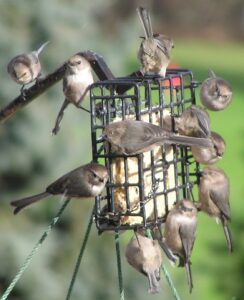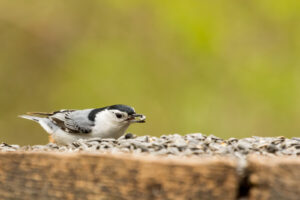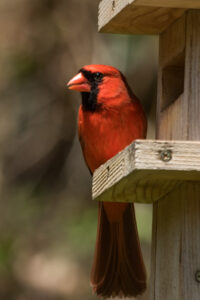If you’ve never set up a bird feeder before, you may be worried that birds will not find it right away.
On the other hand, if you already have a bird feeder set up, your question often changes. How did they come so fast? How do the birds know I filled the feeder?
Birds find newly filled feeders using their excellent eyesight and listening to other birds fighting excitedly over food. They are constantly searching for food sources and investigate new objects in their territory. Once they find a feeder with seed, they keep going back to see if it is filled again.


Can wild birds smell bird seeds?
Experiments have revealed that most birds have a poor sense of smell. Their sense of smell is on par with humans or less sensitive. Both humans and birds have 3 conchae, the organs responsible for the sense of smell.
There are a few birds that do have a good sense of smell.
Turkey Vultures can locate carrion by smell.
Petrels can smell chemicals given off by plankton to find food in the oceans. These birds also use the sense of smell to find their correct nest burrows in colonies dug into sod on offshore islands.
Kiwi birds in New Zealand use smell to locate prey underground as they probe with their bills.
Parrots are said to have a good sense of smell.
But these are the exceptions.
Birds do not use smell to locate feeders or to tell if seeds or other food is present.


Then how do birds find bird feeders?
Birds primarily use vision, their sense of sight, to locate food.
Birds may see seeds that they recognize as food in your feeder. But to do so, they have to be pretty close.
Some birds of prey (hawks, eagles, falcons) have excellent visual acuity–they can detect prey very well–even from a long distance away.
Many birds, including hummingbirds and robins, at least, can see into the ultraviolet. That allows them to see different “colors” in what appears to human eyes to be a single color. But that doesn’t mean they can see bird seed any farther away than you or I can.
So to attract birds to a new feeder, you may spread some seed on the ground. They have a better chance of spotting the seed, then.
Birds recognize bird feeders the same way you do–through experience. A bird feeder is a small object shaped like a bowl or box next to the big square structure (house) where people live. It has bird food in it. Once they learn where to find food, they keep coming back.
Birds are very curious creatures. They explore their small territory on a constant look out for two things. Birds are constantly looking around to escape danger. Birds are constantly looking around to find food.
Birds also keep an eye out on their neighbors. Other birds, whether the same species or not, may alert them to dangers or food sources. If other birds are gathered around a small area, fluttering and hopping, it may be food!
But that’s not all. When a group of birds are eating they most always squawk and fight over the food. They make quite a loud noise sometimes when they are eating in such a group. If you listen, you can also hear birds at your feeder.
So hearing is the second way that birds locate bird feeders.


So how do birds know when I put out food?
Seeds come from plants. Seed eating birds must remember where those plants are and visit them regularly.
The same is true for bird feeders. Birds visit bird feeders regularly, perhaps several times during the day. They may not know how the food gets in the feeder. But they keep checking back.
On the other hand, birds may see you put food in the feeder. Or they may have learned that after people go near the feeder, there may be a new supply of food. Remember that birds keep an eye out for danger? Humans can be dangerous. So if you are out in your yard, the birds are keeping an eye on you!
So that’s it , then. Birds may see you fill the feeders. Or, they check back at feeders several times each day and find new food. Once a bird or two visits a newly-filled feeder other birds see and hear and follow them.
It can seem like birds have a special sense to just “know” when you have refilled your feeder. But they just watch, listen, and visit regularly.


Wrapping Up
So, the answer to how do birds know when I fill up the bird feeder is actually quite simple. They keep watch.
Birds have exceptionally keen eyesight, far surpassing that of humans. They can detect subtle color variations, ultraviolet light, and even perceive movement from great distances. This allows them to spot tiny insects, berries, and seeds amidst foliage. Some raptors like hawks have incredible binocular vision for pinpointing prey.
Frequently Asked Questions
How long will it take for birds to find a bird feeder?
The time it takes for birds to find a bird feeder depends on several factors, making it difficult to give a precise answer. Here’s what influences the discovery timeframe:
Feeder Placement: A feeder placed in a visible location with clear sightlines from surrounding areas gets noticed faster than one hidden by foliage or tucked away in a corner.
Activity in the area: If other birds are already visiting nearby feeders or natural food sources, it attracts new birds and encourages them to explore, potentially leading them to your feeder sooner.
Local bird populations: If your area has a diverse and abundant bird population, the chances of them finding your feeder quickly are higher.
Existing food sources: During times of plentiful natural food availability, like spring or summer, birds may not immediately rely on feeders and take longer to discover them.
How do I attract birds to my bird feeder?
Here are some tips to entice feathered friends.
Visibility: Place your feeder in a visible spot, preferably near shrubs or trees for cover but with clear sightlines to avoid predators.
Accessibility: Ensure birds can easily access the feeder without obstacles, avoiding dangling branches or direct sunlight.
Safety: Keep the feeder away from windows to prevent collisions and out of reach of predators like cats or squirrels.
Do birds tell other birds where food is?
Birds don’t use words or maps to tell each other where food is, but they do have ways of communicating food sources to their fellow feathered friends. Here are a few:
Calls and songs: Birds have a complex language of calls and songs that convey a variety of information, including the location of food. For example, a chickadee’s “chick-a-dee-dee” call can alert other chickadees to a good feeding spot.
Body language: Birds can also use their body language to signal the presence of food. For example, a robin that finds a patch of ripe berries may bob its head and flick its wings, inviting other robins to join in the feast.
Following each other: If one bird sees another bird feeding in a particular spot, it may follow that bird to see what it’s found. This is especially common among social birds, such as crows and jays.

